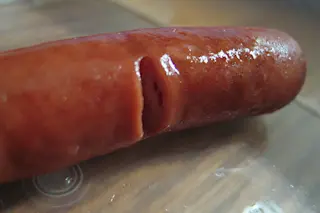Photo: flickr/saraeOf the 1000+ papers we have blogged about, this one is probably my favorite. Not only is it technically surprising (the scientists were able to identify which tissues and organs are present in the "meat" of different brands of supermarket-bought hotdogs by staining thin sections of the weiners), but it's also supremely disgusting (nerve tissue and blood vessels...ugh). A winning combo, if there ever was one! Be sure to check out the awesome figure after the jump!Applying morphologic techniques to evaluate hotdogs: what is in the hotdogs we eat? "Americans consume billions of hotdogs per year resulting in more than a billion dollars in retail sales. Package labels typically list some type of meat as the primary ingredient. The purpose of this study is to assess the meat and water content of several hotdog brands to determine if the package labels are accurate. Eight brands of hotdogs were evaluated ...
Friday Flashback: Ever wanted to know what's really in hotdogs?
Discover how hotdog ingredient labels can be misleading, revealing surprising meat and water content in supermarket-bought hotdogs.
More on Discover
Stay Curious
SubscribeTo The Magazine
Save up to 40% off the cover price when you subscribe to Discover magazine.
Subscribe













